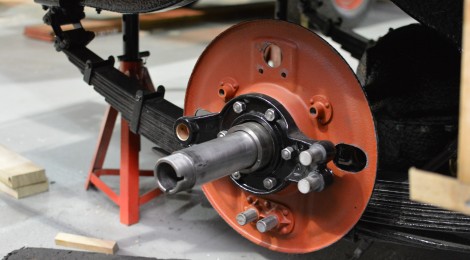
T&I News Update Week 7 2015…
Covering the period up to and including Saturday February 21st 2015
Site work
Below: The signalbox at Rowley Station is now nearing completion, with the new porch made, fitted and painted. Numerous other details are also being completed with the interior also receiving a makeover.
Below: The new locomotive servicing pit at Rowley has now had the block and brickwork completed (in one week flat) and will be shuttered for the pour of concrete to fill the gap between the block walls and create a six inch deep and 14 inch or so wide lintel to which the chairs will be fitted. At the same time the cast iron pillars for the safety barrier on the coal platform will be fitted. We will then focus on the water supply and delivery components of the servicing area, including provision of electrical points for period lighting both here and in the adjacent Council Depot display.
Below: Following its half term operation, Portbury is tucked away pending the start of the high season operation at the end of March. Having seen its quarters in Bristol, we are giving some thought to creating a similar insulated enclosure for locomotives in the RMS – happier for both engines and crews!
Below: In the Colliery the installation of the new turnout has reached a stage where the rails have been installed and some chairs fastened down. Once the rest of the chairs are secured and the rails gauged, the final levelling and packing can be contemplated.
Leyland Cub restoration progress
Below: It goes without saying that Seb Marshall and his team continue to make astonishing progress on the reconstruction of ex Crosville Leyland Cub No.716 – our next vehicle adapted for increased accessibility. We start the latest suite of images with a few photos of the differential and worm-drive following its heavy overhaul and reassembly.
Below: The rear axle is seen fitted with the assembled diff just visible to the right.
Below: The front and rear spring assemblies have also been fitted – seen in component form and then fitted to the bus’ chassis. Reference to previous posts on this bus will reveal some of these items in an earlier stage of their restoration, with these views hopefully putting them into context on the bus itself.
Below: Work on the body structure is also developing – here the windscreen assembly is in place.
Below: The roof hoops have also been fitted using some of the original timbers – notably the rebated curved sections seen in this close up. The new timber and the seamless blending of the two is also readily apparent.
Below: The floor panels (Buffalo Board) have now been cut and fitted. These are a modern specification to provide the strength expected on a modern accessible bus and counter a major flaw in Beamish’s existing bus (whose floors are a constant source of irritation needing regular repair and strengthening). It may be recalled that the floor structure has also been strengthened and great care has been taken to design these panels in such a way as to enable later renewal without wholesale dismantling of the vehicle.
Below: Finally a couple of shots showing the progress on the body structure, notable for the positioning of the roof hoops. The complex destination box area has also been completed. The original panelwork for the front and rear domes is thought to be reusable and in due course the skinning of the bus will transform its appearance, likewise its final sitting onto its wheels – which will also give us the final height to the top of the ramp. The ramp is 3m long and is the maximum that can be incorporated. The lower the bus, the easier the gradient, which is further aided by the fact our buses have a driver and conductor able to assist visitors using this. I think that the opportunity to ride on a real vehicle with real history (and smells!) will make this vehicle unique as a heritage attraction solution to road vehicle adaptation – until we do the second Cub of course! Obviously this bus cannot ‘kneel’ like modern ones, but we are a museum and I am very excited about what is being created here and for those who will (hopefully!) appreciate its appearance at Beamish to aid their visit and add to their experience of real history.
Narrow Gauge waggon construction
Below: Matt and I had a decent Saturday working on the ‘Joicey Waggon’ as the former Hudson ammunition/bomb wagon is know referred to (by me, at least!). We assembled the floor and solebars – the former being a 1 inch marine ply base with steel bonded to the surface. We then assembled the previously prepared sides to complete the basic body tub with requires further finishing and painting before the ironwork (more or less all made now) is fitted. Livery will be grey, with black ironwork and some appropriate signwriting. Couplings of a forged hook and link type are in preparation, and these will be mounted beneath the timber buffer beams which we have yet to make. The aim is to complete it for the Great North Steam Fair… The shape is inspired to a large degree by the Heywood 15 inch gauge open wagons, but with addition of a small brakeman’s compartment to take advantage of the very effective brakes on all-four wheels of the Hudson chassis. A new hand wheel of large proportions has been prepared for the waggon.
































Recent Comments